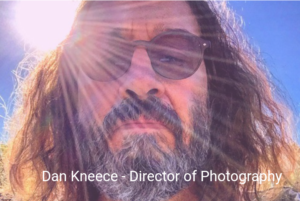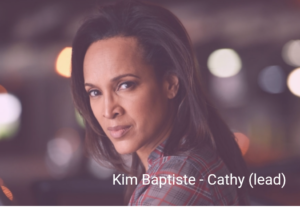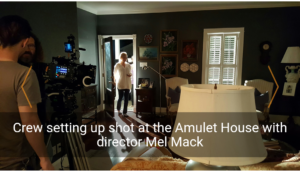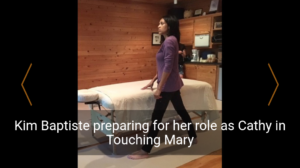This summer, I had the joy of discovering the work of several independent filmmakers who are genuinely making a difference in this sect of the world of film. One of those immensely gifted ladies just happens to be Mel Mack, director and writer of the indie short film Touching Mary. She eagerly agreed to chat with me about her experience in the industry, the making of this singularly thought-provoking short film, and a little about what she sees in her future.

RH: How did you get started in the entertainment industry?
MM: I always wanted to be an actor or something like that when I was a kid. I used to love watching Shirley Temple films. My first inclination was to be in the circus when I was three or four years old. I even had a stage name. I had really curly blonde hair, and it was really frizzy and almost white in color. So I gave myself the name Martha Fuzz. I would announce myself as I went down the slide, “Martha Fuzz, the greatest circus actress in the world!” I did my first commercial when I was about nineteen or twenty, and I just dabbled in it from there.
But then I got really involved when I realized how entertainment can be an intervention for kids–theater-based intervention, school programs. As a result, I think I became more interested in writing than acting. When you write, you can really delve into characters in almost a spiritual way. I liked being able to create and control an entire world.
 Although I’ve been writing for awhile, this is the first script I’ve actually decided to film because I had some people I felt I could trust to guide me along, and I knew it would be okay to make mistakes. One person in particular was the DP, Dan Kneece. He has an amazing bio–be sure to check it out on our movie’s webpage. He’s from South Carolina, but he’s been living in LA for awhile. It would normally be intimidating to work with a director of photography from LA, but since he was from South Carolina, we had that Southern culture connection. He’s a very patient, kind-hearted person that I look up to. I knew he would help guide me, and it would be okay to make mistakes. It wouldn’t be humiliating.
Although I’ve been writing for awhile, this is the first script I’ve actually decided to film because I had some people I felt I could trust to guide me along, and I knew it would be okay to make mistakes. One person in particular was the DP, Dan Kneece. He has an amazing bio–be sure to check it out on our movie’s webpage. He’s from South Carolina, but he’s been living in LA for awhile. It would normally be intimidating to work with a director of photography from LA, but since he was from South Carolina, we had that Southern culture connection. He’s a very patient, kind-hearted person that I look up to. I knew he would help guide me, and it would be okay to make mistakes. It wouldn’t be humiliating.  Kim Baptiste, our lead actor, is also an amazingly talented, professional, and patient person. Those were the two people who really helped me do this the first time. And now I’m working on features, and I’m so excited to do them too!
Kim Baptiste, our lead actor, is also an amazingly talented, professional, and patient person. Those were the two people who really helped me do this the first time. And now I’m working on features, and I’m so excited to do them too!
What’s the overall premise of Touching Mary?
It’s about two women who see each other every day, but don’t really know each other. Part of it is seeing homeless people as valuable members of your community rather than just seeing them as fixtures on the street that you wish would go away. It’s seeing them actually as people.
The larger theme I would say for Touching Mary is that you’re not alone and love never ever really dies. It’s always there. And I’ve left the ending of the film open-ended to whatever your belief is. You can look at it from your own point of view. I’m a person of faith, so I see the ending one way, but someone else could see the ending completely different. They could just see that the main character is so grief-stricken that everything that has happened in the film is a delusion. Or they could see it as this is just a very lonely homeless woman and she has in her delusional mind that she is hungry and she is out on the streets. So there are several possible endings, and I didn’t want to stuff anything down anyone’s throat. But either way, I think it’s a very beautiful ending, and I leave it up to the viewer to choose the ending based on their own perspective.
I think that sounds intriguing. I like those kinds of shorts that leave you somewhat hanging and everyone tends to see the story a little bit differently.
That was the intention of this film. The intention is to stir people’s souls, whether they are believers in God or not. Even if you’re not, it’s going to stir your soul about homeless people. The homeless person in the story is the hero. The lead character is a massage therapist who is wanting to escape her grief. She’s just lost her husband, her child, and her mom just died that night. She’s been taking care of her mom, so she really hasn’t been able to take care of her clients. So in her desperate attempt to escape for one night, she tries to get back a sense of normalcy and ends up massaging the homeless woman. Since it is her profession, she doesn’t think that much about it. But in our society, the homeless tend to be the untouchables.
I love how you are able to weave the faith element into the film. It sounds like it’s a component of the film, but it’s intended for all viewers.
Exactly. The last thing any Christian should do is try to exclude people. So it’s very subtle. I feel like hope, faith, and love encapsulates what this film is about. In the beginning, it’s about hope. It turns to faith, and in the end, you see the love.
How long did Touching Mary take to film?
We had to film in a different location which was five hours from New Orleans, so we put in agonizingly long days. We worked at least twelve hours a day and one day, nearly twenty hours straight to try to get this done. We were working on a tight budget. We had brought up a really large crew with the intention to do that. Everybody else had to get back to their jobs. It was four very long days. But I have to say that the whole project came together so easily. In a lot of ways, it was so much easier than I ever thought it would be even though we worked really hard and had long hours. But we ended up with the most amazing location as well as amazing and helpful people. The producer {Renee Henry} is a woman, and when I told her about this script and then sent it to her, she said, “Mel, whatever you need.” And she helped me to get post-production done in record time. It was just unbelievable.
 I would invite you to look up the location where the movie was filmed. These people built a meditation labyrinth in a forest in the middle of nowhere in Lousiana. It’s truly a place of spiritual feeling when you go there. And the people are so kind and loving.The woman who hosted us cooked us Indian food. And then she ended up being the body double for the homeless lady because our actress was much younger and we just put special effect latex on her face to make her look like a haggard woman who had had an extremely hard life. And she is supposed to be a hard-living, sixty-five-year-old woman. It was such an extraordinary experience meeting all these people who have been so supportive. Women who typically read the script tend to identify more with the homeless woman. This feeling of not being seen and not being heard and how lonely that can be. I think it really touched a lot of women, and they are very supportive of the film.
I would invite you to look up the location where the movie was filmed. These people built a meditation labyrinth in a forest in the middle of nowhere in Lousiana. It’s truly a place of spiritual feeling when you go there. And the people are so kind and loving.The woman who hosted us cooked us Indian food. And then she ended up being the body double for the homeless lady because our actress was much younger and we just put special effect latex on her face to make her look like a haggard woman who had had an extremely hard life. And she is supposed to be a hard-living, sixty-five-year-old woman. It was such an extraordinary experience meeting all these people who have been so supportive. Women who typically read the script tend to identify more with the homeless woman. This feeling of not being seen and not being heard and how lonely that can be. I think it really touched a lot of women, and they are very supportive of the film.
 How long did it take for you to write this film?
How long did it take for you to write this film?
The first draft of the script I probably wrote in three days. I just kept layering in pieces. I probably did a total of five revised scripts, but it was just a matter of layering different elements into the film. If you added up the days, it probably took me six days. But the story just kinda wrote itself. I thought about the story while I was on vacation over the Christmas holidays, and it just came out.
So what is the status of Touching Mary now?
We filmed it April 22-25, and we finished post-production around July 12. We are now actively working to get it into film festivals, and we will keep everyone updated as we get more information on screenings.
After it runs the festival circuit, what are your plans for distribution?
I plan for this to be hitting film festivals for the next year. After that, I’ll put it up online. I’m super proud of it. It was my first film, but it was written, directed, and produced by women. The main cast are all women. It’s a truly unique film. I look forward to the day when I can share it.
There is one more thing I’d like to share about the film.
When I was writing Touching Mary, the main character’s name is Cassie. The homeless woman’s name is Mary. The lead character’s name is actually Mary Catherine Olivier Miller, but she goes by Cassie. In essence, they’re both Mary. So it has a metaphorical thing to it. But I kept hearing this Cassie character in my head as I was writing because they always develop distinct voices in my head. And she had a British accent, and she was very proper. A little bit bourgeoisie. So when it came time to cast, I kept thinking, “Who can I get? I don’t know anyone in New Orleans who has a British accent. I don’t have any female friends who have a British accent period.”
 I thought of Kim Baptiste, but I was so hesitant to call her because her mother had just moved into her home and had severe Alzheimer’s. She was dealing at with all the stuff my character had just dealt with in the death of her mother. She actually jumped at the chance ’cause it gave her an outlet for her feelings. She gave such an amazing performance. I had written the thing. I had read it a hundred times. We were all sitting there in this house filming one of her scenes, and the crew was crying. I was crying. Because her performance was that powerful. And I knew what lines were coming next, but it was just the way she embodied the character.
I thought of Kim Baptiste, but I was so hesitant to call her because her mother had just moved into her home and had severe Alzheimer’s. She was dealing at with all the stuff my character had just dealt with in the death of her mother. She actually jumped at the chance ’cause it gave her an outlet for her feelings. She gave such an amazing performance. I had written the thing. I had read it a hundred times. We were all sitting there in this house filming one of her scenes, and the crew was crying. I was crying. Because her performance was that powerful. And I knew what lines were coming next, but it was just the way she embodied the character.
Are there any other upcoming works that you can mention?
There’s a film I have been writing, and I have become so invested emotionally with the character that I was talking with my friend about the character, and I started crying. It was like I could see the entire film in my mind. I knew what was going to happen. I’ve never been like this with a character. It’s a film that takes place in New Orleans. The main character is an older woman. She’s a very feisty Southern woman named Rusty. My goal, my dream would be to have Susan Surandon play her. But I know that’s highly unlikely. I’m so excited about it. It will be so much easier to film because we can do it right here in New Orleans. So that will be my next thing to film.
I am always astounded by the incredible diversity within the world of independent film, and Mel is one who has leaped headfirst into a world of her creation with fairly satisfying results. While she may not be receiving some of the notoriety that some filmmakers receive, Mel is proud of what she has accomplished, and I agree that she should be. It is the easiest thing to remain on the outside and do nothing but judge and criticize the works of others within the entertainment industry. That’s what the vast majority of people do in this day and age. But it is a totally different experience to take the plunge and actually do something, and Mel has chosen to do what a select few do–create and share her own work. She quite adroitly invited others to accompany and aid her on this new path, and she viewed this as a learning experience. As she has arrived at the culmination of her labor, she is ready to spring into the next phase–promotion and exhibition. While she sends her film out into the universe, there will be those who are indifferent, cruel, and highly critical. However, there will also be those who will be touched by this film of hers. And for every person who is roused, inspired, and receptive to the overall message of the film, Mel will be able to take pride in knowing her film was an impetus to change. Even if all she does is plant seeds, that is her purpose with this first film which will no doubt go on to stimulate so many people and hopefully lead to lasting change, at least in some circles. So be sure that you follow both Mel and her short film at the links below. Furthermore, keep your eye on the career of this budding filmmaker as she is just embarking on a career that is destined to become a fount of blessing and positivity for the months and years ahead.
FOLLOW MEL
FOLLOW TOUCHING MARY



